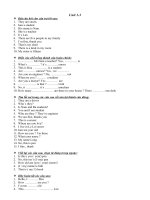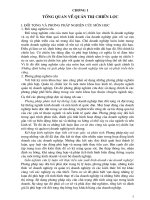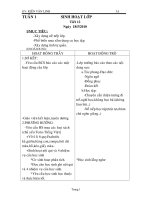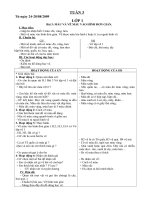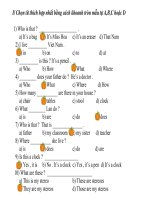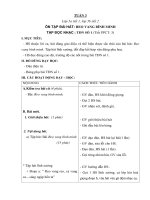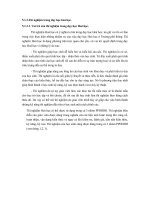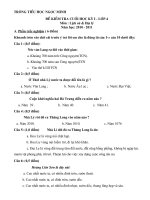- Trang chủ >>
- Mầm non - Tiểu học >>
- Lớp 5
5 1 3 harvesting medicine on the hill
Bạn đang xem bản rút gọn của tài liệu. Xem và tải ngay bản đầy đủ của tài liệu tại đây (4.3 MB, 14 trang )
Suggested levels for Guided Reading, DRA,™
Lexile,® and Reading Recovery™ are provided
in the Pearson Scott Foresman Leveling Guide.
Ha r v esting
Har
Medicine on
the Hill
by Joyce Guttmacher
illustrated by Kate McKeon
Genre
Historical
fiction
Comprehension
Skills and Strategy
• Setting and Theme
• Draw Conclusions
• Visualize
Scott Foresman Reading Street 5.1.3
ISBN 0-328-13510-0
ì<(sk$m)=bdfbad< +^-Ä-U-Ä-U
Reader Response
Har vesting
Medicine on
the Hill
1. Describe the setting of this story—both the place and
time. Use a chart like the one below to organize your
thoughts. How does this setting contribute to what
happens in the story?
Setting
Time
Place
2. Imagine that you are Red Hawk. Visualize how your
life would be different if you lived in a Chumash
village in the late sixteenth century. What would be
the same?
3. This story makes use of several Chumash words, such
as ‘ap, and tomol, which are never defined. Given its
context, what do you think ‘ap means? On page 9,
Grandfather says, “We should not stand here idly.”
From the context, what does idly mean?
by Joyce Guttmacher
4. Red Hawk asks, “Grandfather, will the doctors be able
by Kate
McKeon
to protect illustrated
us if the southern
sickness
comes here?”
What do you think will happen to the boy and his
village in the coming months?
Editorial Offices: Glenview, Illinois • Parsippany, New Jersey • New York, New York
Sales Offices: Needham, Massachusetts • Duluth, Georgia • Glenview, Illinois
Coppell, Texas • Ontario, California • Mesa, Arizona
Every effort has been made to secure permission and provide appropriate credit for
photographic material. The publisher deeply regrets any omission and pledges to
correct errors called to its attention in subsequent editions.
Unless otherwise acknowledged, all photographs are the property of Scott Foresman,
a division of Pearson Education.
Photo locators denoted as follows: Top (T), Center (C), Bottom (B), Left (L), Right (R),
Background (Bkgd)
© Layne Kennedy/Corbis; 1 © Robert Holmes/Corbis; 7 © Layne Kennedy/Corbis; 8 ©
Patrick Johns/Corbis; 11 © Raymond Gehman/Corbis; 12 © Academy of Natural Sciences
of Philadelphia/Corbis; 13 © Darrell Gulin/Corbis; 14A © Inga Spence/Visuals Unlimited/
Getty Images; 14B © Michelle Garrett/Corbis; 16 © Tom Bean/Corbis; 19 © George D.
Lepp/Corbis; 21 © Historical Picture Archive/Corbis; 22A © Historical Picture Archive/
Corbis; 22B © Susan Rosenthal/Corbis; 24
ISBN: 0-328-13510-0
Copyright © Pearson Education, Inc.
Picture yourself in a pharmacy, standing in front
of the shelves of medicines. Rows and rows of
perfectly shaped pills in white sterile bottles, topped
off with balls of cotton and tamper-proof caps,
stand at attention. Now turn around, and imagine
time slipping backwards, backwards, backwards. The
flickering fluorescent lights fade, the walls of the
store dissolve away, and you are—where?
All Rights Reserved. Printed in the United States of America. This publication is
protected by Copyright, and permission should be obtained from the publisher
prior to any prohibited reproduction, storage in a retrieval system, or transmission
in any form by any means, electronic, mechanical, photocopying, recording, or
likewise. For information regarding permission(s), write to: Permissions Department,
Scott Foresman, 1900 East Lake Avenue, Glenview, Illinois 60025.
2 3 4 5 6 7 8 9 10 V0G1 14 13 12 11 10 09 08 07 06 05
3
It is a long, long time ago in the 1500s, and
you are standing alone on the crest of a hill that
overlooks the wild California coast. Gnarled oaks
spot the golden yellow hills beneath you, all the way
down to where the ocean crashes against the shore.
The pharmacy is gone and all the medicines in it—or
are they?
Surprising as it might seem, the slopes of these
sun-baked hills are a kind of pharmacy. The brush,
bushes, wildflowers, and weeds have all been used
for thousands of years to cure and prevent illness.
As you look over this hill of wildly flowering
medicines, you see an old man hobbling up the steep
side of the hill. Somehow, you know him. His name is
4
Bent Oak Kitsepawit, and he is a Chumash elder. You
also recognize his grandson, Red Hawk, following at
a respectful distance. The bit of root around his neck
bounces on his collarbone as he scrambles up the
slopes.
“Are we almost there?” he calls out to Bent Oak.
“If I remember correctly,” the old man replies. “I
saw some chuchupate growing by the marshy place
near the stream, back last spring.”
“Why didn’t you pick it in the spring, then?” the
boy asks innocently.
“Remember, my child,” Bent Oak answers evenly,
“we do not pick chuchupate in the spring. We pick it
in fall, when all the power is in the roots.”
5
Bent Oak squats beside another plant and asks,
“Do you recall what yerba mansa is used for?”
Red Hawk is still learning—it has only been a year
now that he has been accompanying his grandfather
to the hills. “Yerba mansa cures burning pains under
the skin,” he recites slowly and carefully.
“That’s right, my child,” Bent Oak replies. “Put
yerba mansa on wounds and they will heal. Drink it
as tea to purify the blood. We will pull up the roots
now, bring them back to the ‘ap, and dry them. In a
few weeks, we can slice them and begin to use them
for medicine.”
As Bent Oak stands and looks toward the
coast, he frowns at a building, much larger than
the ‘ap where he and the boy live, that is under
construction.
“What are they doing, Grandfather?” the boy
asks about the foreigners who are working on the
strange-looking building.
“They are cutting down too many of our oak
trees,” Bent Oak says curtly. “That takes too many
trees that give food.”
Red Hawk nods. Though most of the food in the
village comes from the sea, they eat bread from the
chia, or acorns—the seeds of the oak tree—every
day.
Red Hawk looks back to where the workers labor
on the building for the Spanish strangers. He can see
them breaking up the earth to plant seeds. What will
their arrival mean to our people? he wonders.
A Spanish mission
6
7
“We should not stand here idly,” says the
grandfather, turning his back on the new building.
“We have many more medicinal plants to find.” The
urgency in Bent Oak’s voice makes the boy uneasy.
He thinks about the rumors he has heard at night
in the ‘ap, about the sickness in the south, where
people break out in rashes of oozing red sores. They
said the sick went blind or died. Red Hawk worries
that the sickness will reach his village too. For weeks,
he has been afraid to ask his grandfather whether
the sickness will continue its deadly trek up north.
Casting a last nervous look behind him, Red Hawk
asks, “What else do we need?” trying to hide his
fear.
The old man touches his hand to the bit of
twisted root he wears on a cord around his neck. It is
an answer, and the boy understands. “Chuchupate,”
Bent Oak smiles. “And do you remember why it is
important?”
“It guards against rattlesnakes,” the boy
answers promptly. “Grandmother chews the root
for headaches. Uncle rubs it on his sore body after
fishing, and mother gives me chuchupate tea when I
am sick with a cold.”
The grandfather nods. “Yes, chuchupate has many
uses. You can see how important it is that we bring
more home to the village. Come up the hill to where
it grows. You should know by now where to find it.”
Chuchupate
8
9
“Grandfather,” the boy pants, scrambling after
the old medicine man, “if the chuchupate is so
important, why don’t we plant it near the village?”
“Chuchupate does not consent to be grown just
anywhere,” Bent Oak answers. “Some plants can
be cultivated, but chuchupate only grows where it
wants. Do you remember why we must be careful
when we pick chuchupate?”
Red Hawk says slowly and thoughtfully, “It is
because we take the root. If we only took the flower,
the plant would still be there next year. But because
we take the root, there will be no plants left at all if
we take too much.”
His grandfather nods. “That is why,” Bent
Oak says, “and that is what the strangers do not
understand. I do not want to tell them about the
chuchupate.”
“Don’t they know about it?” the boy asks
curiously. The old man shakes his head. The boy is
amazed. “And is it true that they have no doctors—
no pipe doctors, or ant doctors, or herb doctors?”
Ruda, a medicinal herb
10
11
Poison oak
Bent Oak speaks as they walk, “I don’t believe they
have doctors like our doctors, and I’ve heard they look
down on our pipe doctors and other shaman. They
have their own cures and their own plants. Some say
that the plant called rue is good for earache. It grows
in their gardens. But they do not know our remedies
and perhaps should not try to use them.”
The boy thinks about the pipe doctors who suck
out whatever is causing disease through their long
stone pipes. Thinking of sickness reminds him of
the sick people in the south. He does not want to
think about that; instead, he asks Bent Oak why the
Spanish don’t use their medicines.
“Well, Red Hawk, think of this. Do you remember
what should be used for warts and rashes on the
skin?”
12
“You must use the juice of the poison oak when it
is cut in the spring,” Red Hawk recites from memory.
The old man nods. “The poison oak plant is
important because it is a cure and a poison. It can
cure stomach upset if you boil it and drink it when
cool, but you must keep the smoke out of your
eyes, or it could blind you.” The boy nods, for he
remembers boiling it last summer.
“Why did you say the Spanish should not use it?”
“When they touch the plant,” Bent Oak replies,
“they break out in a terrible rash. It is very strange,
that one people should be affected by it when
another is not, but perhaps there is a reason.” Seeing
Red Hawk’s discomfort, Bent Oak asks gently, “If you
had a rash, what could you do for it?”
“Mugwort,” the boy answers quickly. “I would
make a tea of mugwort leaves, and use it to bathe
the rash.”
Mugwort
13
The old man nods proudly. “You remember well.
What else is the mugwort used for?”
“You make the dried leaves into a little cone.
Then you put it on a wound to keep it from
becoming infected,” answers Red Hawk.
“Yes,” the grandfather nods. “That is right.” Bent
Oak strides across the hill with the boy following
behind. Beautiful twisted oaks make patterns against
the yellow grass and the blue sky. The relentless
autumn sun releases the rich smell of the grass, and
the boy breathes deeply. The old man listens to the
sawing drone of the insects and admires the sudden
flight of the birds that nested there. It is the way it
has always been.
Red Hawk, however, worries and squeezes
his eyes shut. He wants to hear his grandfather
assure him that there are plants that will cure the
sickness brought to the people in the south by the
strangers who have invaded their land. He wants his
grandfather to say that the pipe doctors will be able
to suck it away.
But Red Hawk’s grandfather says nothing. He
merely walks on, unhurried, planting one foot in
front of the other as if there is no terrible sickness to
the south.
The boy follows behind, trying to mimic his
grandfather’s easy gait, hoping it will quell the
worry in his own heart. Then his grandfather stops
and squats beside a tall hairy-stemmed plant that
stands among the grasses, its bell-shaped flowers still
blooming, even in September.
Owl’s clover
Coyote
tobacco
14
15
“Coyote tobacco,” the boy volunteers, without
being asked. “Its smoke is used by the pipe doctors.”
“That’s right,” the old man smiles. “The pipe
doctor blows its smoke over the sick, so that they will
get better. Do you remember other uses for coyote
tobacco?”
“We drink it for stomach pains,” the boy says,
“and also rub it where the body hurts. I had it on
my ears before they were pierced so they would not
hurt too much.”
Bent Oak nods, “Yes, it is good for you to
remember these things, for someday it may be you
who teach others.”
It was strange. Last year, before the Spanish came
and the sickness came, the boy loved to hear his
grandfather’s praise. He loved hearing that someday
it would be he who would know the healing powers
of plants.
Sep. Note:
clip basket as
shown here
16
17
But today, his grandfather’s words sound
ominous. Red Hawk fears that if the sickness comes
and takes his grandfather, he will not remember
when to harvest the chuchupate and how to prepare
the coyote tobacco. Perhaps no one else will know.
Will our doctors protect us? Red Hawk wants to
ask. The question leaves a bitter taste in his mouth.
He does not want to ask it, however, and—as if from
a distance—he hears his grandfather say that the
doctors can do little.
When the strange building reappears over the
rise, he cannot help but ask, “Grandfather, will the
doctors be able to protect us if the southern sickness
comes here?”
18
His grandfather stops walking, turns, and stands
stock-still facing the boy. Looking as if words have
escaped from him, he gives his answer slowly,
deliberately. “I do not know.”
The boy closes his eyes. There is sadness in his
grandfather’s voice such as he has never heard
before. Red Hawk knows that his grandfather, too, is
worried about the sickness that follows the Spanish.
When he opens his eyes again, his grandfather is
gazing at him gently.
“There is one plant we have not discussed today,
my child. Perhaps it will help us. Do you know which
plant I am talking about?”
19
The boy does. It is toloache, the jimsonweed,
and it is very dangerous—too much toloache causes
blindness, insanity, and death. Taken in moderation,
toloache is also a powerful way to strengthen the
body and protect it. The boy knows that people take
it to clean the blood or dull the worst pain.
Toloache is so potent that it needs to be prepared
in a special way. It must be done by a relative,
preferably the mother or grandmother of the person
who is to take it. It must never be done lightly. The
boy wonders if he should take toloache to ward off
the unknown sickness if it comes to his village.
They go together over the fields, searching, until
they come to a tall plant with enormous white
flowers like trumpets—a bushy plant that comes up
to the boy’s middle.
“You must be careful,” his grandfather says,
holding the boy back as he reaches to grasp the
plant. “Toloache is dangerous. It can even hurt the
skin.” The boy watches how the old man harvests the
plant carefully.
“Will the toloache save us?” the boy asks.
“My son, it is not the plants that cure us, you
know that. Sickness comes from imbalance and must
be cured by restoring balance. The pipe doctor can
suck out whatever it is that is making us sick. The
power of the plants is in how they are used—how
the mother prepares the toloache, how the pipe
doctor blows his smoke over the patient. That is
what you must remember.”
Toloache
20
21
The village is bustling when the boy and his
grandfather return to the ‘ap with their collection
of plants. Several women sit outside in the dusk,
weaving baskets, while two girls dye more rushes
to be used in making baskets. The boy spies his own
mother, crouching beside a fire. A large basket is
on the ground beside her. His mother’s baskets are
so tightly woven that they can hold water. Now
she heats up rocks in the fire—when they are hot
enough she will put them into the acorn gruel in the
basket and cook it for supper.
A few men come up the path from the sea,
carrying the day’s catch of fish. Some boys play with
walnut shell dice in the dirt, while others throw a
sharp pole through a circle of willow. In the distance,
the steam rises from the ‘apa’yik, or sweathouse,
where the men sit to cleanse and purify themselves
and talk about the day’s events.
The boy looks up to where the sun carries its torch
of burning bark across the sky. Soon it will sink in the
west, sending a shower of sparks across the sky to
shine in the dark and give comfort in the night.
He remembers what his grandfather always says:
other people must struggle to live, but his people
have all that they want for the taking. Instead of
working in the dirt, they have time to play games, to
weave beautiful baskets, to carve the tomol canoes
that carry them over the sea to the islands. Red
Hawk vows he will do everything in his power to
help preserve his people and their way of life.
22
23
Medicines from Nature
Reader Response
All over the world, in all times and places, human
beings have used plants to treat illness and injury.
Plants with antibacterial or antifungal properties
(like yerba mansa, goldenseal, and others) have been
used over the years to:
• treat infections
• slow down or speed up respiration and heart rate
• kill pain, bring down fever, aid breathing
• treat warts and rashes
• bring on or delay childbirth
1. Describe the setting of this story—both the place and
time. Use a chart like the one below to organize your
thoughts. How does this setting contribute to what
happens in the story?
Although there are not enough experiments
to measure the effectiveness of herbal remedies,
the chemical composition of many plants has been
shown to have measurable effects on the human
body. Moreover, several plants are the basis for
modern medicines:
• The foxglove plant is used in
the heart drug digitalis.
• Poppy seeds are used in the
pain medication morphine.
• The mayapple is used in the
wart medicine podophyllum.
One of the most common
drugs of all comes from the
willow. Native Americans have
long boiled down this plant to
make a tea to bring down fever
and dull pain. Today, people
buy that cure in a drugstore
and call it aspirin.
24
Setting
Time
Place
2. Imagine that you are Red Hawk. Visualize how your
life would be different if you lived in a Chumash
village in the late sixteenth century. What would be
the same?
3. This story makes use of several Chumash words, such
as ‘ap, and tomol, which are never defined. Given its
context, what do you think ‘ap means? On page 9,
Grandfather says, “We should not stand here idly.”
From the context, what does idly mean?
4. Red Hawk asks, “Grandfather, will the doctors be able
to protect us if the southern sickness comes here?”
What do you think will happen to the boy and his
village in the coming months?

